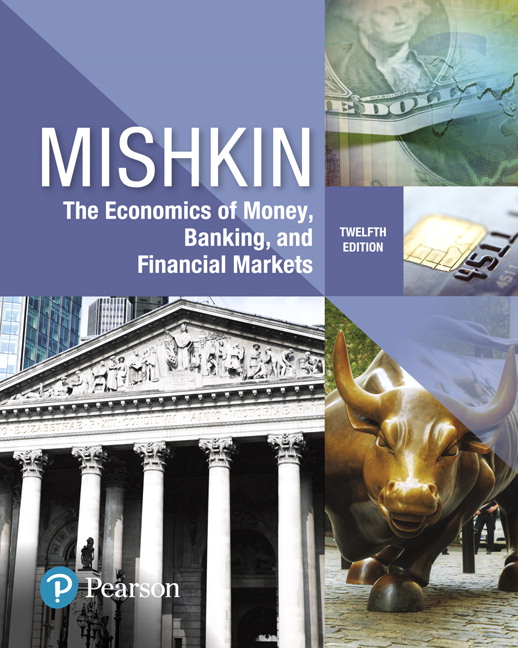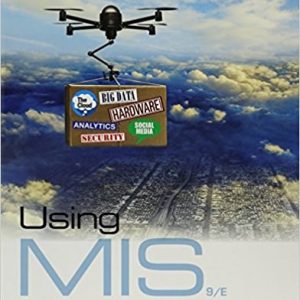This is completed downloadable of Test Bank for Economics of Money Banking and Financial Markets 12th Edition by Mishkin

Product Details:
- ISBN-10 : 0134733827
- ISBN-13 : 978-0134733821
- Author: Frederic S. Mishkin
The Economics of Money, Banking and Financial Markets brings a fresh perspective to today’s major questions surrounding financial policy. Influenced by his term as Governor of the Federal Reserve, Frederic Mishkin offers students a unique viewpoint and informed insight into the monetary policy process, the regulation and supervision of the financial system, and the internationalization of financial markets. The 12th Edition provides a unifying, analytic framework for learning that fits a wide variety of syllabi. Core economic principles and real-world examples organize students’ thinking and keeps them motivated.
Table of Content:
- Part 1 Introduction Crisis and Response: Global Financial Crisis and Its Aftermath
- 1 Why Study Money, Banking, and Financial Markets?
- Preview
- Learning Objectives
- Why Study Financial Markets?
- Debt Markets and Interest Rates
- The Stock Market
- Why Study Financial Institutions and Banking?
- Structure of the Financial System
- Banks and Other Financial Institutions
- Financial Innovation
- Financial Crises
- Why Study Money and Monetary Policy?
- Money and Business Cycles
- Money and Inflation
- Money and Interest Rates
- Conduct of Monetary Policy
- Fiscal Policy and Monetary Policy
- Why Study International Finance?
- The Foreign Exchange Market
- The International Financial System
- Money, Banking, and Financial Markets and Your Career
- How We Will Study Money, Banking, and Financial Markets
- Exploring the Web
- Concluding Remarks
- Summary
- Key Terms
- Questions
- Applied Problems
- Data Analysis Problems
- Web Exercises
- Web References
- Appendix to Chapter 1 Defining Aggregate Output, Income, the Price Level, and the Inflation Rate
- Aggregate Output and Income
- Real Versus Nominal Magnitudes
- Aggregate Price Level
- Growth Rates and the Inflation Rate
- 2 An Overview of the Financial System
- Preview
- Learning Objectives
- Function of Financial Markets
- Structure of Financial Markets
- Debt and Equity Markets
- Primary and Secondary Markets
- Exchanges and Over-the-Counter Markets
- Money and Capital Markets
- Financial Market Instruments
- Money Market Instruments
- U.S. Treasury Bills
- Negotiable Bank Certificates of Deposit
- Commercial Paper
- Repurchase Agreements
- Federal (Fed) Funds
- Capital Market Instruments
- Stocks
- Mortgages and Mortgage-Backed Securities
- Corporate Bonds
- U.S. Government Securities
- U.S. Government Agency Securities
- State and Local Government Bonds
- Consumer and Bank Commercial Loans
- Internationalization of Financial Markets
- International Bond Market, Eurobonds, and Eurocurrencies
- World Stock Markets
- Function of Financial Intermediaries: Indirect Finance
- Transaction Costs
- Risk Sharing
- Asymmetric Information: Adverse Selection and Moral Hazard
- Economies of Scope and Conflicts of Interest
- Types of Financial Intermediaries
- Depository Institutions
- Commercial Banks
- Savings and Loan Associations (S&Ls) and Mutual Savings Banks
- Credit Unions
- Contractual Savings Institutions
- Life Insurance Companies
- Fire and Casualty Insurance Companies
- Pension Funds and Government Retirement Funds
- Investment Intermediaries
- Finance Companies
- Mutual Funds
- Money Market Mutual Funds
- Hedge Funds
- Investment Banks
- Regulation of the Financial System
- Increasing Information Available to Investors
- Ensuring the Soundness of Financial Intermediaries
- Restrictions on Entry
- Disclosure
- Restrictions on Assets and Activities
- Deposit Insurance
- Limits on Competition
- Restrictions on Interest Rates
- Financial Regulation Abroad
- Summary
- Key Terms
- Questions
- Applied Problems
- Data Analysis Problems
- Web Exercises
- Web References
- 3 What Is Money?
- Preview
- Learning Objectives
- Meaning of Money
- Functions of Money
- Medium of Exchange
- Unit of Account
- Store of Value
- Evolution of the Payments System
- Commodity Money
- Fiat Money
- Checks
- Electronic Payment
- E-Money
- Measuring Money
- The Federal Reserve’s Monetary Aggregates
- Summary
- Key Terms
- Questions
- Applied Problems
- Data Analysis Problems
- Web Exercises
- Web References
- Part 2 Financial Markets Crisis and Response: Credit Market Turmoil and the Stock Market Crash of October 2008
- 4 The Meaning of Interest Rates
- Preview
- Learning Objectives
- Measuring Interest Rates
- Present Value
- Four Types of Credit Market Instruments
- Yield to Maturity
- Simple Loan
- Fixed-Payment Loan
- Coupon Bond
- Discount Bond
- Summary
- The Distinction Between Interest Rates And Returns
- Maturity and the Volatility of Bond Returns: Interest-Rate Risk
- Summary
- The Distinction Between Real And Nominal Interest Rates
- Summary
- Key Terms
- Questions
- Applied Problems
- Data Analysis Problems
- Web Exercises
- Web References
- 5 The Behavior of Interest Rates
- Preview
- Learning Objectives
- Determinants of Asset Demand
- Wealth
- Expected Returns
- Risk
- Liquidity
- Theory of Portfolio Choice
- Supply and Demand in the Bond Market
- Demand Curve
- Supply Curve
- Market Equilibrium
- Supply and Demand Analysis
- Changes in Equilibrium Interest Rates
- Shifts in the Demand for Bonds
- Wealth
- Expected Returns
- Risk
- Liquidity
- Shifts in the Supply of Bonds
- Expected Profitability of Investment Opportunities
- Expected Inflation
- Government Budget Deficits
- Supply and Demand in the Market for Money: The Liquidity Preference Framework
- Changes in Equilibrium Interest Rates in the Liquidity Preference Framework
- Shifts in the Demand for Money
- Income Effect
- Price-Level Effect
- Shifts in the Supply of Money
- Money and Interest Rates
- Summary
- Key Terms
- Questions
- Applied Problems
- Data Analysis Problems
- Web Exercises
- Web References
- 6 The Risk and Term Structure of Interest Rates
- Preview
- Learning Objectives
- Risk Structure of Interest Rates
- Default Risk
- Liquidity
- Income Tax Considerations
- Summary
- Term Structure of Interest Rates
- Expectations Theory
- Segmented Markets Theory
- Liquidity Premium and Preferred Habitat Theories
- Evidence on the Term Structure
- Summary
- Summary
- Key Terms
- Questions
- Applied Problems
- Data Analysis Problems
- Web Exercises
- Web References
- 7 The Stock Market, the Theory of Rational Expectations, and the Efficient Market Hypothesis
- Preview
- Learning Objectives
- Computing the Price of Common Stock
- The One-Period Valuation Model
- The Generalized Dividend Valuation Model
- The Gordon Growth Model
- How the Market Sets Stock Prices
- The Theory of Rational Expectations
- Formal Statement of the Theory
- Rationale Behind the Theory
- Implications of the Theory
- The Efficient Market Hypothesis: Rational Expectations in Financial Markets
- Rationale Behind the Hypothesis
- Random-Walk Behavior of Stock Prices
- Why the Efficient Market Hypothesis Does Not Imply That Financial Markets Are Efficient
- Behavioral Finance
- Summary
- Key Terms
- Questions
- Applied Problems
- Data Analysis Problems
- Web Exercises
- Web References
- Part 3 Financial Institutions Crisis and Response: The $700 Billion Bailout Package
- 8 An Economic Analysis of Financial Structure
- Preview
- Learning Objectives
- Basic Facts About Financial Structure Throughout The World
- Transaction Costs
- How Transaction Costs Influence Financial Structure
- How Financial Intermediaries Reduce Transaction Costs
- Economies of Scale
- Expertise
- Asymmetric Information: Adverse Selection and Moral Hazard
- The Lemons Problem: How Adverse Selection Influences Financial Structure
- Lemons in the Stock and Bond Markets
- Tools to Help Solve Adverse Selection Problems
- Private Production and Sale of Information
- Government Regulation to Increase Information
- Financial Intermediation
- Collateral and Net Worth
- Summary
- How Moral Hazard Affects the Choice Between Debt and Equity Contracts
- Moral Hazard in Equity Contracts: The Principal–Agent Problem
- Tools to Help Solve the Principal–Agent Problem
- Production of Information: Monitoring
- Government Regulation to Increase Information
- Financial Intermediation
- Debt Contracts
- How Moral Hazard Influences Financial Structure in Debt Markets
- Tools to Help Solve Moral Hazard in Debt Contracts
- Net Worth and Collateral
- Monitoring and Enforcement of Restrictive Covenants
- Financial Intermediation
- Summary
- Summary
- Key Terms
- Questions
- Applied Problems
- Data Analysis Problems
- Web Exercises
- Web References
- 9 Banking and the Management of Financial Institutions
- Preview
- Learning Objectives
- The Bank Balance Sheet
- Liabilities
- Checkable Deposits
- Nontransaction Deposits
- Borrowings
- Bank Capital
- Assets
- Reserves
- Cash Items in Process of Collection
- Deposits at Other Banks
- Securities
- Loans
- Other Assets
- Basic Banking
- General Principles of Bank Management
- Liquidity Management and the Role of Reserves
- Asset Management
- Liability Management
- Capital Adequacy Management
- How Bank Capital Helps Prevent Bank Failure
- How the Amount of Bank Capital Affects Returns to Equity Holders
- Trade-Off Between Safety and Returns to Equity Holders
- Bank Capital Requirements
- Managing Credit Risk
- Screening and Monitoring
- Screening
- Specialization in Lending
- Monitoring and Enforcement of Restrictive Covenants
- Long-Term Customer Relationships
- Loan Commitments
- Collateral and Compensating Balances
- Credit Rationing
- Managing Interest-Rate Risk
- Gap and Duration Analysis
- Off-Balance-Sheet Activities
- Loan Sales
- Generation of Fee Income
- Trading Activities and Risk Management Techniques
- Summary
- Key Terms
- Questions
- Applied Problems
- Data Analysis Problems
- Web Exercises
- Web References
- 10 Economic Analysis of Financial Regulation
- Preview
- Learning Objectives
- Asymmetric Information as a Rationale for Financial Regulation
- Government Safety Net
- Bank Panics and the Need for Deposit Insurance
- Other Forms of the Government Safety Net
- Drawbacks of the Government Safety Net
- Moral Hazard and the Government Safety Net
- Adverse Selection and the Government Safety Net
- “Too Big to Fail”
- Financial Consolidation and the Government Safety Net
- Types of Financial Regulation
- Restrictions on Asset Holdings
- Capital Requirements
- Prompt Corrective Action
- Financial Supervision: Chartering and Examination
- Assessment of Risk Management
- Disclosure Requirements
- Consumer Protection
- Restrictions on Competition
- Summary
- Summary
- Key Terms
- Questions
- Applied Problems
- Data Analysis Problems
- Web Exercise
- Web References
- 11 Banking Industry: Structure and Competition
- Preview
- Learning Objectives
- Historical Development of the Banking System
- Multiple Regulatory Agencies
- Financial Innovation and the Growth of the “Shadow Banking System”
- Responses to Changes in Demand Conditions: Interest-Rate Volatility
- Adjustable-Rate Mortgages
- Financial Derivatives
- Responses to Changes in Supply Conditions: Information Technology
- Bank Credit and Debit Cards
- Electronic Banking
- Junk Bonds
- Commercial Paper Market
- Securitization and the Shadow Banking System
- How the Shadow Banking System Works
- Subprime Mortgage Market
- Avoidance of Existing Regulations
- Money Market Mutual Funds
- Sweep Accounts
- Financial Innovation and the Decline of Traditional Banking
- Decline in Cost Advantages in Acquiring Funds (Liabilities)
- Decline in Income Advantages on Uses of Funds (Assets)
- Banks’ Responses
- Decline of Traditional Banking in Other Industrialized Countries
- Structure of the U.S. Commercial Banking Industry
- Restrictions on Branching
- Response to Branching Restrictions
- Bank Holding Companies
- Automated Teller Machines
- Bank Consolidation and Nationwide Banking
- The Riegle-Neal Interstate Banking and Branching Efficiency Act of 1994
- What Will the Structure of the U.S. Banking Industry Look Like in the Future?
- Are Bank Consolidation and Nationwide Banking Good Things?
- Separation of Banking and Other Financial Service Industries
- Erosion of Glass-Steagall
- The Gramm-Leach-Bliley Financial Services Modernization Act of 1999: Repeal of Glass-Steagall
- Implications for Financial Consolidation
- Separation of Banking and Other Financial Services Industries Throughout the World
- Thrift Industry: Regulation and Structure
- Savings and Loan Associations
- Mutual Savings Banks
- Credit Unions
- International Banking
- Eurodollar Market
- Structure of U.S. Banking Overseas
- Foreign Banks in the United States
- Summary
- Key Terms
- Questions
- Data Analysis Problems
- Web Exercises
- Web References
- 12 Financial Crises
- Preview
- Learning Objectives
- What Is a Financial Crisis?
- Dynamics of Financial Crises
- Stage One: Initial Phase
- Credit Boom and Bust
- Asset-Price Boom and Bust
- Increase in Uncertainty
- Stage Two: Banking Crisis
- Stage Three: Debt Deflation
- The Global Financial Crisis of 2007–2009
- Causes of the 2007–2009 Financial Crisis
- Financial Innovation in the Mortgage Markets
- Agency Problems in the Mortgage Markets
- Asymmetric Information and Credit-Rating Agencies
- Effects of the 2007–2009 Financial Crisis
- Residential Housing Prices: Boom and Bust
- Deterioration of Financial Institutions’ Balance Sheets
- Run on the Shadow Banking System
- Global Financial Markets
- Failure of High-Profile Firms
- Height of the 2007–2009 Financial Crisis
- Government Intervention and the Recovery
- Response of Financial Regulation
- Macroprudential Versus Microprudential Supervision
- Dodd-Frank Wall Street Reform and Consumer Protection Act of 2010
- Consumer Protection
- Annual Stress Tests
- Resolution Authority
- Limits on Federal Reserve Lending
- Systemic Risk Regulation
- Volcker Rule
- Derivatives
- Too-Big-to-Fail and Future Regulation
- What Can Be Done About the Too-Big-to-Fail Problem?
- Break Up Large, Systemically Important Financial Institutions
- Higher Capital Requirements
- Leave It to Dodd-Frank
- Beyond Dodd-Frank: Where Might Regulation Head in the Future?
- Consumer Protection
- Resolution Authority
- Volcker Rule
- Derivatives Trading
- Government-Sponsored Enterprises (GSEs)
- Summary
- Key Terms
- Questions
- Data Analysis Problems
- Web Exercises
- Web Reference
- Part 4 Central Banking and the Conduct of Monetary Policy Crisis and Response: The Federal Reserve and the Global Financial Crisis
- 13 Central Banks and the Federal Reserve System
- Preview
- Learning Objectives
- Origins of the Federal Reserve System
- Structure of the Federal Reserve System
- Federal Reserve Banks
- Member Banks
- Board of Governors of the Federal Reserve System
- Federal Open Market Committee (FOMC)
- Why the Chair of the Board of Governors Really Runs the Show
- How Independent Is the Fed?
- Should the Fed be Independent?
- The Case for Independence
- The Case Against Independence
- Central Bank Independence and Macroeconomic Performance Throughout the World
- Explaining Central Bank Behavior
- Structure and Independence of the European Central Bank
- Differences Between the European System of Central Banks and the Federal Reserve System
- Governing Council
- How Independent Is the ECB?
- Structure and Independence of Other Foreign Central Banks
- Bank of Canada
- Bank of England
- Bank of Japan
- The Trend Toward Greater Independence
- Summary
- Key Terms
- Questions
- Data Analysis Problems
- Web Exercises
- Web References
- 14 The Money Supply Process
- Preview
- Learning Objectives
- Three Players in the Money Supply Process
- The Fed’s Balance Sheet
- Liabilities
- Assets
- Control of the Monetary Base
- Federal Reserve Open Market Operations
- Open Market Purchase
- Open Market Sale
- Shifts from Deposits into Currency
- Loans to Financial Institutions
- Other Factors That Affect the Monetary Base
- Overview of the Fed’s Ability to Control the Monetary Base
- Multiple Deposit Creation: A Simple Model
- Deposit Creation: The Single Bank
- Deposit Creation: The Banking System
- Deriving the Formula for Multiple Deposit Creation
- Critique of the Simple Model
- Factors That Determine the Money Supply
- Changes in the Nonborrowed Monetary Base, MBn
- Changes in Borrowed Reserves, BR, from the Fed
- Changes in the Required Reserve Ratio, rr
- Changes in Excess Reserves
- Changes in Currency Holdings
- Overview of the Money Supply Process
- The Money Multiplier
- Deriving the Money Multiplier
- Intuition Behind the Money Multiplier
- Money Supply Response to Changes in the Factors
- Summary
- Key Terms
- Questions
- Applied Problems
- Data Analysis Problems
- Web Exercises
- Web References
- 15 Tools of Monetary Policy
- Preview
- Learning Objectives
- The Market for Reserves and the Federal Funds Rate
- Demand and Supply in the Market for Reserves
- Demand Curve
- Supply Curve
- Market Equilibrium
- How Changes in the Tools of Monetary Policy Affect the Federal Funds Rate
- Open Market Operations
- Discount Lending
- Reserve Requirements
- Interest on Reserves
- Conventional Monetary Policy Tools
- Open Market Operations
- Discount Policy and the Lender of Last Resort
- Operation of the Discount Window
- Lender of Last Resort
- Reserve Requirements
- Interest on Reserves
- Relative Advantages of the Different Tools
- Nonconventional Monetary Policy Tools and Quantitative Easing
- Liquidity Provision
- Large-Scale Asset Purchases
- Quantitative Easing Versus Credit Easing
- Forward Guidance
- Negative Interest Rates on Banks’ Deposits
- Monetary Policy Tools of the European Central Bank
- Open Market Operations
- Lending to Banks
- Interest on Reserves
- Reserve Requirements
- Summary
- Key Terms
- Questions
- Applied Problems
- Data Analysis Problems
- Web Exercises
- Web References
- 16 The Conduct of Monetary Policy: Strategy and Tactics
- Preview
- Learning Objectives
- The Price Stability Goal and the Nominal Anchor
- The Role of a Nominal Anchor
- The Time-Inconsistency Problem
- Other Goals of Monetary Policy
- High Employment and Output Stability
- Economic Growth
- Stability of Financial Markets
- Interest-Rate Stability
- Stability in Foreign Exchange Markets
- Should Price Stability Be the Primary Goal of Monetary Policy?
- Hierarchical Versus Dual Mandates
- Price Stability as the Primary, Long-Run Goal of Monetary Policy
- Inflation Targeting
- Inflation Targeting in New Zealand, Canada, and the United Kingdom
- New Zealand
- Canada
- United Kingdom
- Advantages of Inflation Targeting
- Reduction of the Time-Inconsistency Problem
- Increased Transparency
- Increased Accountability
- Consistency with Democratic Principles
- Improved Performance
- Disadvantages of Inflation Targeting
- Delayed Signaling
- Too Much Rigidity
- Potential for Increased Output Fluctuations
- Low Economic Growth
- The Evolution of the Federal Reserve’s Monetary Policy Strategy
- The Fed’s “Just Do It” Monetary Policy Strategy
- The Long Road to Inflation Targeting
- Lessons for Monetary Policy Strategy from the Global Financial Crisis
- Implications for Inflation Targeting
- Level of the Inflation Target
- Flexibility of Inflation Targeting
- Should Central Banks Try to Stop Asset-Price Bubbles?
- Two Types of Asset-Price Bubbles
- Credit-Driven Bubbles
- Bubbles Driven Solely by Irrational Exuberance
- The Debate over Whether Central Banks Should Try to Pop Bubbles
- Con: Why Central Banks Should Not Try to Prick Asset-Price Bubbles but Should Just Clean Up After They Burst
- Pro: Why Central Banks Should Try to Pop Bubbles
- Macroprudential Policies
- Monetary Policy
- Tactics: Choosing the Policy Instrument
- Criteria for Choosing the Policy Instrument
- Observability and Measurability
- Controllability
- Predictable Effect on Goals
- Tactics: The Taylor Rule
- Summary
- Key Terms
- Questions
- Applied Problems
- Data Analysis Problems
- Web Exercises
- Web References
- Part 5 International Finance and Monetary Policy Crisis and Response: Foreign Exchange Market Turmoil and the IMF
- 17 The Foreign Exchange Market
- Preview
- Learning Objectives
- Foreign Exchange Market
- What Are Foreign Exchange Rates?
- Why Are Exchange Rates Important?
- How Is Foreign Exchange Traded?
- Exchange Rates in the Long Run
- Theory of Purchasing Power Parity
- Evidence on Purchasing Power Parity
- Why the Theory of Purchasing Power Parity Cannot Fully Explain Exchange Rates
- PPP Does Not Hold Exactly, But It Has Predictive Power
- Departures from PPP: Overvaluations and Undervaluations
- Factors That Affect Exchange Rates in the Long Run
- Relative Price Levels
- Trade Barriers
- Preferences for Domestic Versus Foreign Goods
- Productivity
- Exchange Rates in the Short Run: A Supply and Demand Analysis
- Supply Curve for Domestic Assets
- Demand Curve for Domestic Assets
- Equilibrium in the Foreign Exchange Market
- Explaining Changes in Exchange Rates
- Shifts in the Demand for Domestic Assets
- Domestic Interest Rate, iD
- Foreign Interest Rate, iF
- Changes in the Expected Future Exchange Rate,
- Recap: Factors That Change the Exchange Rate
- Summary
- Key Terms
- Questions
- Applied Problems
- Data Analysis Problems
- Web Exercises
- Web References
- Appendix to Chapter 17 The Interest Parity Condition
- Comparing Expected Returns on Domestic and Foreign Assets
- Interest Parity Condition
- 18 The International Financial System
- Learning Objectives
- Preview
- Intervention in the Foreign Exchange Market
- Foreign Exchange Intervention and the Money Supply
- Unsterilized Intervention
- Sterilized Intervention
- Balance of Payments
- Current Account
- Financial Account
- Exchange Rate Regimes in the International Financial System
- Gold Standard
- The Bretton Woods System
- How a Fixed Exchange Rate Regime Works
- Devaluation and Revaluation
- Perfect Capital Mobility
- Speculative Attacks
- The Policy Trilemma
- Monetary Unions
- Managed Float
- Capital Controls
- Controls on Capital Outflows
- Controls on Capital Inflows
- The Role of the IMF
- Should the IMF Act as an International Lender of Last Resort?
- International Considerations and Monetary Policy
- Direct Effects of the Foreign Exchange Market on Monetary Policy
- Exchange Rate Considerations
- To Peg or Not to Peg: Exchange-Rate Targeting as an Alternative Monetary Policy Strategy
- Advantages of Exchange-Rate Targeting
- Disadvantages of Exchange-Rate Targeting
- When Is Exchange-Rate Targeting Desirable for Industrialized Countries?
- When Is Exchange-Rate Targeting Desirable for Emerging Market Countries?
- Currency Boards
- Dollarization
- Summary
- Key Terms
- Questions
- Applied Problems
- Data Analysis Problems
- Web Exercises
- Web References
- Part 6 Monetary Theory Crisis and Response: The Perfect Storm of 2007–2009
- 19 Quantity Theory, Inflation, and the Demand for Money
- Preview
- Learning Objectives
- Quantity Theory of Money
- Velocity of Money and Equation of Exchange
- Determinants of Velocity
- Demand for Money
- From the Equation of Exchange to the Quantity Theory of Money
- Quantity Theory and the Price Level
- Quantity Theory and Inflation
- Budget Deficits and Inflation
- Government Budget Constraint
- Hyperinflation
- Keynesian Theories of Money Demand
- Transactions Motive
- Precautionary Motive
- Speculative Motive
- Putting the Three Motives Together
- Portfolio Theories of Money Demand
- Theory of Portfolio Choice and Keynesian Liquidity Preference
- Other Factors That Affect the Demand for Money
- Wealth
- Risk
- Liquidity of Other Assets
- Summary
- Empirical Evidence for the Demand for Money
- Interest Rates and Money Demand
- Stability of Money Demand
- Summary
- Key Terms
- Questions
- Applied Problems
- Data Analysis Problems
- Web Exercises
- Web References
- 20 The IS Curve
- Preview
- Learning Objectives
- Planned Expenditure and Aggregate Demand
- The Components of Aggregate Demand
- Consumption Expenditure
- Consumption Function
- Planned Investment Spending
- Fixed Investment
- Inventory Investment
- Planned Investment Spending and Real Interest Rates
- Planned Investment and Business Expectations
- Investment Function
- Government Purchases and Taxes
- Government Purchases
- Taxes
- Net Exports
- Real Interest Rates and Net Exports
- Autonomous Net Exports
- Net Export Function
- Goods Market Equilibrium
- Solving for Goods Market Equilibrium
- Deriving the IS Curve
- Understanding the IS Curve
- What the IS Curve Tells Us: Intuition
- What the IS Curve Tells Us: Numerical Example
- Why the Economy Heads Toward Equilibrium
- Factors That Shift the IS Curve
- Changes in Government Purchases
- Changes in Taxes
- Changes in Autonomous Spending
- Autonomous Consumption
- Autonomous Investment Spending
- Autonomous Net Exports
- Changes in Financial Frictions
- Summary of Factors That Shift the IS Curve
- Summary
- Key Terms
- Questions
- Applied Problems
- Data Analysis Problems
- Web Exercises
- Web References
- 21 The Monetary Policy and Aggregate Demand Curves
- Preview
- Learning Objectives
- The Federal Reserve and Monetary Policy
- The Monetary Policy Curve
- The Taylor Principle: Why the Monetary Policy Curve Has an Upward Slope
- Shifts in the MP Curve
- Movements Along Versus Shifts in the MP Curve
- The Aggregate Demand Curve
- Deriving the Aggregate Demand Curve Graphically
- Factors That Shift the Aggregate Demand Curve
- Shifts in the IS Curve
- Shifts in the MP Curve
- Summary
- Key Terms
- Questions
- Applied Problems
- Data Analysis Problems
- Web Exercises
- Web References
- 22 Aggregate Demand and Supply Analysis
- Preview
- Learning Objectives
- Aggregate Demand
- Deriving the Aggregate Demand Curve
- Factors That Shift the Aggregate Demand Curve
- Aggregate Supply
- Long-Run Aggregate Supply Curve
- Short-Run Aggregate Supply Curve
- Expected Inflation, πe
- Output Gap
- Inflation (Supply) Shocks
- Short-Run Aggregate Supply Curve
- Why the Short-Run Aggregate Supply Curve Is Upward-Sloping
- Price Stickiness and the Short-Run Aggregate Supply Curve
- Shifts in the Aggregate Supply Curves
- Shifts in the Long-Run Aggregate Supply Curve
- Shifts in the Short-Run Aggregate Supply Curve
- Expected Inflation
- Inflation Shock
- Persistent Output Gap
- Equilibrium in Aggregate Demand and Supply Analysis
- Short-Run Equilibrium
- How the Short-Run Equilibrium Moves to the Long-Run Equilibrium over Time
- Self-Correcting Mechanism
- Changes in Equilibrium: Aggregate Demand Shocks
- Changes in Equilibrium: Aggregate Supply (INFLATION) Shocks
- Temporary Supply Shocks
- Permanent Supply Shocks and Real Business Cycle Theory
- Conclusions
- AD/AS Analysis of Foreign Business Cycle Episodes
- Summary
- Key Terms
- Questions
- Applied Problems
- Data Analysis Problems
- Web Exercises
- Web References
- Appendix to Chapter 22 The Phillips Curve and the Short-Run Aggregate Supply Curve
- The Phillips Curve
- Phillips Curve Analysis in the 1960s
- The Friedman-Phelps Phillips Curve Analysis
- The Phillips Curve After the 1960s
- The Modern Phillips Curve
- The Modern Phillips Curve with Adaptive (Backward-Looking) Expectations
- The Short-Run Aggregate Supply Curve
- 23 Monetary Policy Theory
- Preview
- Learning Objectives
- Response of Monetary Policy to Shocks
- Response to an Aggregate Demand Shock
- No Policy Response
- Policy Stabilizes Economic Activity and Inflation in the Short Run
- Response to a Permanent Supply Shock
- No Policy Response
- Policy Stabilizes Inflation
- Response to a Temporary Supply Shock
- No Policy Response
- Policy Stabilizes Inflation in the Short Run
- Policy Stabilizes Economic Activity in the Short Run
- The Bottom Line: The Relationship Between Stabilizing Inflation and Stabilizing Economic Activity
- How Actively Should Policymakers Try to Stabilize Economic Activity?
- Lags and Policy Implementation
- Inflation: Always and Everywhere a Monetary Phenomenon
- Causes of Inflationary Monetary Policy
- High Employment Targets and Inflation
- Cost-Push Inflation
- Demand-Pull Inflation
- Cost-Push Versus Demand-Pull Inflation
- Monetary Policy at the Zero Lower Bound
- Deriving the Aggregate Demand Curve with the Zero Lower Bound
- The Disappearance of the Self-Correcting Mechanism at the Zero Lower Bound
- Summary
- Key Terms
- Questions
- Applied Problems
- Data Analysis Problems
- Web Exercises
- Web Reference
- 24 The Role of Expectations in Monetary Policy
- Preview
- Learning Objectives
- Lucas Critique of Policy Evaluation
- Econometric Policy Evaluation
- Policy Conduct: Rules or Discretion?
- Discretion and the Time-Inconsistency Problem
- Types of Rules
- The Case for Rules
- The Case for Discretion
- Constrained Discretion
- The Role of Credibility and a Nominal Anchor
- Benefits of a Credible Nominal Anchor
- Credibility and Aggregate Demand Shocks
- Positive Demand Shock
- Negative Demand Shock
- Credibility and Aggregate Supply Shocks
- Credibility and Anti-Inflation Policy
- Approaches to Establishing Central Bank Credibility
- Nominal GDP Targeting
- Appoint “Conservative” Central Bankers
- Summary
- Key Terms
- Questions
- Applied Problems
- Data Analysis Problems
- Web Exercises
- 25 Transmission Mechanisms of Monetary Policy
- Learning Objectives
- Preview
- Transmission Mechanisms of Monetary Policy
- Traditional Interest-Rate Channels
- Other Asset Price Channels
- Exchange Rate Effects on Net Exports
- Tobin’s q Theory
- Wealth Effects
- Credit View
- Bank Lending Channel
- Balance Sheet Channel
- Cash Flow Channel
- Unanticipated Price Level Channel
- Household Liquidity Effects
- Why Are Credit Channels Likely to Be Important?
- Lessons for Monetary Policy
- Summary
- Key Terms
- Questions
- Applied Problems
- Data Analysis Problems
- Web Exercises
- Web References
- Glossary
- Index





